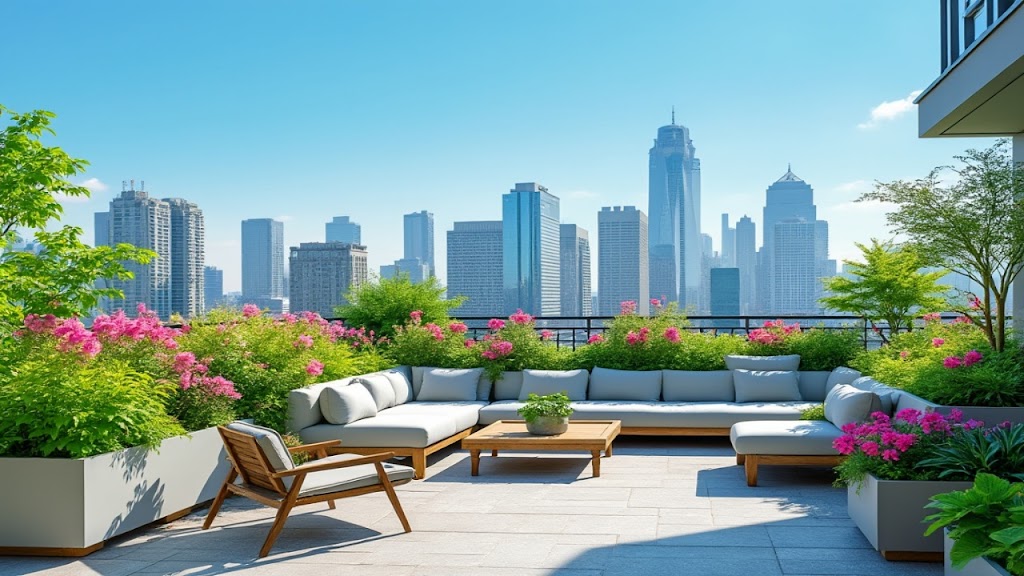In densely populated urban areas, green spaces are often limited. Rooftop gardens offer a practical and innovative solution to this challenge. By transforming unused rooftop areas into lush, productive gardens, city dwellers can enjoy numerous benefits including improved aesthetics, environmental impact, and personal well-being. This article explores the advantages of rooftop gardens, provides design and maintenance tips, and highlights inspiring examples to help you create your own urban oasis.
Discover how rooftop gardens can transform urban living by providing green spaces in the city. Learn about their benefits, design ideas, and practical tips for establishing your own rooftop garden to enhance your lifestyle and the environment.
Benefits of Rooftop Gardens
Rooftop gardens are more than just a trend; they offer a range of benefits that can significantly enhance both the environment and quality of life in urban areas.
Environmental Advantages
Combat Urban Heat Island Effect: Rooftop gardens help reduce the urban heat island effect by cooling down building roofs. This natural cooling process decreases the demand for air conditioning, thus reducing energy consumption and lowering greenhouse gas emissions.
Improve Air Quality: Plants in rooftop gardens absorb carbon dioxide and release oxygen, improving air quality. They also help filter pollutants, contributing to a healthier urban environment.
Enhancing Urban Living
Increase Green Space: Rooftop gardens provide much-needed green space in cities where parks and gardens may be scarce. They offer a private retreat from the hustle and bustle of city life, providing residents with a place to relax and unwind.
Boost Mental Health: Spending time in nature has been shown to reduce stress and improve mental health. A rooftop garden provides a peaceful environment that can help alleviate urban stress and enhance overall well-being.
Aesthetic and Economic Benefits
Visual Appeal: A well-designed rooftop garden can significantly enhance the appearance of a building. The lush greenery contrasts beautifully with the urban landscape, creating a visually appealing environment.
Increase Property Value: Properties with rooftop gardens are often seen as more attractive and desirable. This added feature can increase the market value of a property, making it a worthwhile investment for homeowners.
Designing Your Rooftop Garden
Designing a rooftop garden involves careful planning to ensure that it is functional, aesthetically pleasing, and sustainable. Here are key considerations to keep in mind.
Structural and Safety Considerations
Assessing Structural Integrity: Before starting a rooftop garden project, it is crucial to evaluate the structural capacity of your roof. Consult with a structural engineer to ensure that the roof can support the weight of soil, plants, and garden features.
Waterproofing and Drainage: Proper waterproofing is essential to prevent damage to the building. Install an effective drainage system to manage excess water and prevent leaks, ensuring the longevity of both the garden and the building.
Selecting Plants
Climate Adaptability: Choose plants that are suitable for your local climate and weather conditions. Consider factors such as sunlight exposure, temperature extremes, and wind conditions when selecting plants for your rooftop garden.
Low Maintenance Choices: Opt for plants that require minimal upkeep. Succulents, hardy perennials, and native plants are excellent choices for rooftop gardens due to their durability and low maintenance requirements.
Garden Features and Layout
Seating Areas: Incorporate comfortable seating options such as lounge chairs or benches to create a relaxing space where you can enjoy the garden. Adding outdoor furniture enhances the functionality of the rooftop space.
Vertical Gardens: Utilize vertical space with wall-mounted planters or trellises. These features maximize planting area and add visual interest, making the most of limited rooftop space.
Water Features: Adding a small water feature, such as a fountain or a pond, can enhance the garden’s tranquility. Water features also attract wildlife, contributing to a vibrant and lively environment.
Practical Tips for Maintaining Your Rooftop Garden
Maintaining a rooftop garden requires regular attention to ensure it remains healthy and vibrant. Here are some essential maintenance tips.
Watering and Irrigation
Consistent Watering: Ensure that plants receive adequate water, especially during hot weather. Use an irrigation system or self-watering planters to simplify maintenance and ensure consistent moisture.
Rainwater Collection: Consider installing a rainwater harvesting system to collect and reuse rainwater for irrigation. This sustainable practice reduces water costs and supports eco-friendly gardening.
Seasonal Care
Adapting to Seasons: Plant seasonal flowers and vegetables to keep your garden attractive throughout the year. Rotate plants according to the seasons to maintain a dynamic and colorful garden.
Winter Protection: In colder climates, protect plants from frost and harsh weather conditions. Use frost covers, mulch, or moveable containers to shield plants during winter months.
Pest and Disease Management
Regular Monitoring: Inspect plants regularly for signs of pests and diseases. Early detection and intervention can prevent minor issues from becoming major problems.
Organic Solutions: Use natural pest control methods, such as neem oil or insecticidal soap, to manage pests without harming the environment. Avoid chemical pesticides to maintain a sustainable garden.
Inspiring Examples of Rooftop Gardens
Real-life examples of successful rooftop gardens can provide valuable inspiration for your own project.
Residential Rooftop Gardens
A residential rooftop garden in a high-rise building features a variety of plants, including herbs, flowers, and shrubs. The design includes seating areas and planters, creating a private retreat with stunning city views.
This garden enhances the living experience of the homeowners, providing a personal oasis amidst the urban environment.
Community Rooftop Gardens
A community rooftop garden in an urban apartment complex serves as a shared green space for residents. It includes raised beds for growing vegetables and herbs, as well as communal seating and social areas.
This garden fosters community engagement and offers fresh produce to residents, demonstrating the benefits of communal green spaces in cities.
Commercial Rooftop Gardens
A commercial building features a rooftop garden designed as an employee wellness area. It includes outdoor seating, a small café, and landscaped greenery, creating a relaxing environment for employees.
This garden enhances employee satisfaction and productivity while providing an attractive space for clients and visitors.
Conclusion
Rooftop gardens offer a unique and valuable opportunity to introduce green spaces into urban environments. By carefully planning your garden design, considering practical aspects, and maintaining your garden regularly, you can create a beautiful and functional oasis above the city. Embrace the benefits of rooftop gardens to enhance your living space, contribute to a sustainable urban environment, and enjoy a slice of nature in the heart of the city.

